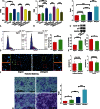Increased expression of pigment epithelium-derived factor in aged mesenchymal stem cells impairs their therapeutic efficacy for attenuating myocardial infarction injury
- PMID: 21606086
- PMCID: PMC3675387
- DOI: 10.1093/eurheartj/ehr131
Increased expression of pigment epithelium-derived factor in aged mesenchymal stem cells impairs their therapeutic efficacy for attenuating myocardial infarction injury
Abstract
Aims: Mesenchymal stem cells (MSCs) can ameliorate myocardial infarction (MI) injury. However, older-donor MSCs seem less efficacious than those from younger donors, and the contributing underlying mechanisms remain unknown. Here, we determine how age-related expression of pigment epithelium-derived factor (PEDF) affects MSC therapeutic efficacy for MI.
Methods and results: Reverse transcriptase-polymerized chain reaction and enzyme-linked immunosorbent assay analyses revealed dramatically increased PEDF expression in MSCs from old mice compared to young mice. Morphological and functional experiments demonstrated significantly impaired old MSC therapeutic efficacy compared with young MSCs in treatment of mice subjected to MI. Immunofluorescent staining demonstrated that administration of old MSCs compared with young MSCs resulted in an infarct region containing fewer endothelial cells, vascular smooth muscle cells, and macrophages, but more fibroblasts. Pigment epithelium-derived factor overexpression in young MSCs impaired the beneficial effects against MI injury, and induced cellular profile changes in the infarct region similar to administration of old MSCs. Knocking down PEDF expression in old MSCs improved MSC therapeutic efficacy, and induced a cellular profile similar to young MSCs administration. Studies in vitro showed that PEDF secreted by MSCs regulated the proliferation and migration of cardiac fibroblasts.
Conclusions: This is the first evidence that paracrine factor PEDF plays critical role in the regulatory effects of MSCs against MI injury. Furthermore, the impaired therapeutic ability of aged MSCs is predominantly caused by increased PEDF secretion. These findings indicate PEDF as a promising novel genetic modification target for improving aged MSC therapeutic efficacy.
Keywords: Mesenchymal stem cells; Myocardial infarction; Paracrine; Pigment epithelium-derived factor.
Figures






References
-
- Sutton MG, Sharpe N. Left ventricular remodeling after myocardial infarction: pathophysiology and therapy. Circulation. 2000;101:2981–2988. - PubMed
-
- Passier R, van Laake LW, Mummery CL. Stem-cell-based therapy and lessons from the heart. Nature. 2008;453:322–329. - PubMed
-
- Pittenger MF, Martin BJ. Mesenchymal stem cells and their potential as cardiac therapeutics. Circ Res. 2004;95:9–20. - PubMed
-
- Psaltis PJ, Zannettino AC, Worthley SG, Gronthos S. Concise review: mesenchymal stromal cells: potential for cardiovascular repair. Stem Cells. 2008;26:2201–2210. - PubMed
-
- Meirelles Lda S, Fontes AM, Covas DT, Caplan AI. Mechanisms involved in the therapeutic properties of mesenchymal stem cells. Cytokine Growth Factor Rev. 2009;20:419–427. - PubMed
Publication types
MeSH terms
Substances
LinkOut - more resources
Full Text Sources
Other Literature Sources
Medical
Miscellaneous

